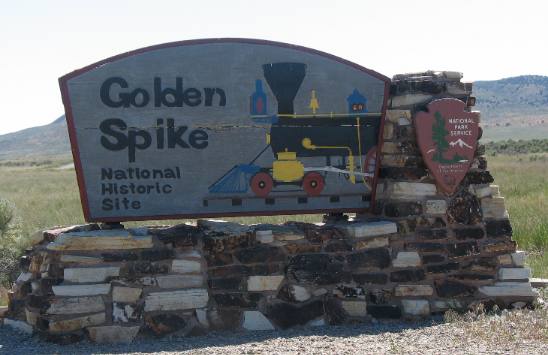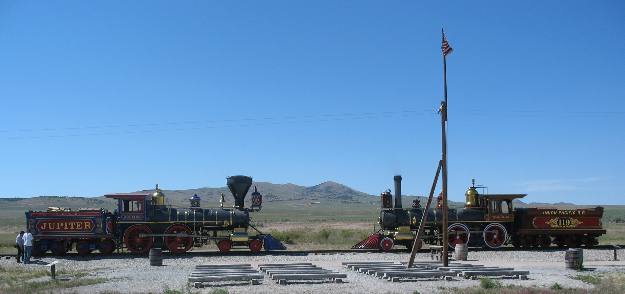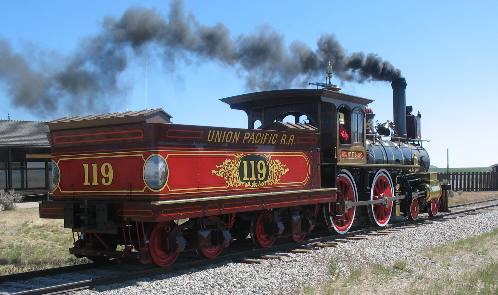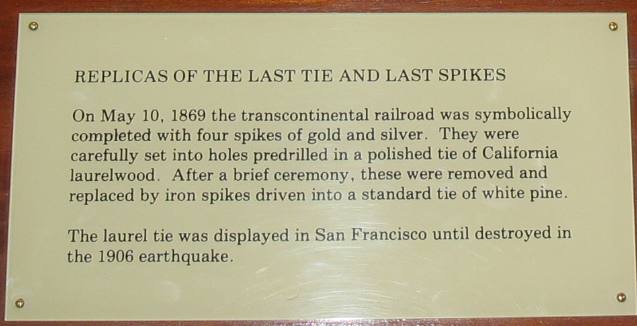Golden Spike National Historic Site at Promnatory,
Utah
May 31, 2007.
This morning we visited Brigham City,
Utah & the Bear
River National Migratory Bird Refuge. We dropped the motorhome at a Super
Wal Mart located at exit 364 and headed to Bear
River National Migratory Bird Refuge 20-miles west of Brigham City, then
to the Golden Spike National
Historic Site at Promnatory, Utah.
To get to the Golden
Spike National Historic Site from I-15 take exit 368 and travel west on
SR 13 to the intersection with SR 83. Continue west on SR-83 for around 25-miles
following the brown signs.

Keep in mind that this is the FIRST part of a two-part
series covering the Golden Spike
National Historic Site. Do not forget to view the second one: Golden
Spike NHS part-2

While
America's first railroads were operating in the 1830s people of vision foresaw
transcontinental travel by rail. This idea gained support as a national RR system
took shape.
By the beginning of the Civil War, America's eastern states
were linked by 31,000 miles of rail, more than in all of Europe. Virtually none
of this network, however, served the area west of the Missouri River.
Until
the Great American Desert and the Rockies were bridged, the vast western territories
would be a part of the nation in name only. A continent-spanning railroad would
also bring more tangible benefits: It would boost trade, shorten emigrants' journey,
and help the army control American Indians who were opposed to white settlement.
Anticipating great financial and political rewards, northern, midwestern, and
southern senators made their cases for locating the eastern terminus in their
regions.
In California, Theodore Judah had his own plan for a transcontinental
railroad. By 1862 the young engineer had surveyed a route over the Sierra Nevada
and persuaded wealthy Sacramento merchants to form the Central Pacific RR. That
year Congress authorized the Central Pacific to build a railroad eastward from
Sacramento and in the same act chartered the Union Pacific RR in New York. The
Civil War had removed the southern senators from the debate over the eastern terminus
location, thus the central route near the Mormon Trail was chosen, with Omaha
as the eastern terminus. Each RR received loan subsidies of $16,000 to $48,000
per-mile, depending on the difficulty of the terrain, and 10 land sections for
each mile of track laid. While work was started in 1863 not much was accomplished
while the country's attention was diverted by the Civil War. Investors could reap
greater profits from the war, and the army had first priority on labor and materials.
Central Pacific's Collis Huntington and UP's Thomas Durant, exemplars of the no-holes-barred
business ethics of the period, visited Washington with enough cash to help congressmen
understand their problems. A second RR Act of 1864 doubled the land subsidies.
Still little track was laid until labor and supplies were freed at war's end.
Central
Pacific crews faced the rugged Sierra range almost immediately. While the Union
Pacific started on easier terrain, its work parties were raided by Sioux and Cheyenne.
With eight flatcars of material needed for each mile of track, supplies were a
logistical nightmare for both RRs, especially Central Pacific, which had to ship
every rail, spike, and locomotive 15,000 miles around Cape Horn. Both pushed ahead
faster than anyone had expected. The work teams, often headed by ex-army officers,
were drilled until they could lay two to five miles of track a day on flat land.
Union
Pacific drew on the vast pool of America's unemployed: Irish, German and Italian
immigrants, Civil War veterans from both sides, ex-slaves, and even American Indians
--8,000 to 10,000 workers in all. It was a volatile mixture, and drunken bloodshed
was common in the "Hell-on-wheels" towns thrown up near the base camps.
Because California's labor pool had been drained by the rush for gold, followed
by the silver boom, Central Pacific hired several thousand Chinese, the backbone
of the railroad's work force.
By mid-1868 Central Pacific crews had crossed
the Sierra and laid 200 miles of track, and the Union Pacific had laid 700 miles
over the plains. As the two work forces neared each other in Utah, they raced
to grade more miles and claim more land subsidies. Both pushed so far beyond their
railheads that they passed each other, and for more than 200 miles competing graders
advanced in opposite directions on parallel grades.
Congress finally declared
the meeting place to be Promontory Summit, where, on May 10, 1869, two locomotives
pulled up to the one-rail gap left in the track. After a golden spike was symbolically
tapped, a final iron spike was driven to connect the railroads. The Central Pacific
laid 690 miles of track; the Union Pacific 1,086. they had crossed 1,776 miles
of desert, rivers, and mountains to bind together East and West.
Thus, the
transformation of the western United States was wrought by two rails four feet
eight and one-half inches apart, snaking across hundreds of miles of sparseness.
They joined two oceans and cemented the political union of states with a physical
link.
It also was a wedge through the frontier. The west at that time belonged
to the American Indians and the enourmous herds of buffalo on which they depended.
Many Indians fought white settlement of their land, but as the railroads brought
in car after car of troops and supplies, the Indians could no longer repel the
army. Settlers flowed in behind and put the land to the plow, while millions of
buffalo were killed.
For the late emigrants, the railroad changed what
it meant to be a pioneer. A journey that had taken six months by ox-drawn wagon
took six or seven days by train. The Union Pacific built railroad stations along
the way, and settlements grew up around them. Some railways sold supplies and
even provided dormatories for emigrants until they could settle. Twenty-one years
after the railroad was completed, the frontier was history.
Even before
it was completed, the railroad had begun to change the West. As the railheads
moved across the land, supply houses and service businesses grew up in their wakes.
Some tent towns like Reno and Cheyenne survived to become respectable cities.
Workers who had been trained on the railroad built towns and staffed factories
and mines.
Another anticipated benefit of the railroad, increased trade
with the Far East--never materialized. The Suez Canal was completed the same year
as the railroad, and Far East goods could now be shipped to Europe faster by way
of the canal than across America. But that loss was compensated for by the rapidly
growing western rail trade, out of which a vigorous, interlocking economy developed.
Western mountains were rich with low-grade silver, lead, and copper ores, made
profitable by long trains of ore cars. They were used by industries in the East,
whose products found a growing market in the West. Western agriculture made geat
advances as new farming techniques, livestock strains, and machinery moved in
by rail. Cash, generated by produce shipped east, poured into the region, and
budding western financiers learned how to raise money to capitalize new industry.
Factories were built, and the growing industrial population provided a new market
for western farm produce.
More than economically, the railroads tied the
West to the eastern states. They altered the very pace of life, putting people
on a schedule who had always geared their activities to natural rhythms. National
politics came west, as candidates made whistle stop tours of small towns in search
of votes. As railroads made travel into the West safe and comfortable, visitors
from the eastern states and Europe toured the "New America".
With
the coming of the railroads, the West, for so long the vast, forbidding "out
there," was brought into the national life.
That folks, pretty much
sums up the signifigance of this Golden Spike Historical Site. It is the place
where the last spike spanning the continent was driven changing forever life across
this country.

The
Visitors Center has on display two recreated icons of railroading history at the
Last Spike Site. Central Pacific's Jupiter and Union Pacific's No 119 steam out
and perform for visitors on most days, weater permitting.

This is Union Pacific's Steam Engine 119 performing for visitors.
Inside
the Visitors Center a museum has exhibits of tools and equipment used to build
the transcontinental railroad in 1869. Also a short video tells the story of the
great race to Promontory.
In addition to tools and equipment a section
is reserved for displaying memorabelia connected with this momentus event.

It
seems there was more than one gold spike. In addition there was several silver
spikes, and other spikes that were a combination of gold, silver and steel.



In my opinion this is one historic
place that everyone should visit. Not for the spectacular scenery but to experience
first hand the awesome achievement this site commemorates.
Until next time remember how good
life is.
Mike
& Joyce Hendrix
Until next time remember how good life
is.

Mike
& Joyce Hendrix who we are
We
hope you liked this page. If you do you might be interested in some of our other
Travel Adventures:
Mike & Joyce Hendrix's
home page
Travel
Adventures by Year ** Travel
Adventures by State ** Plants **
Marine-Boats ** Geology
** Exciting Drives ** Cute
Signs ** RV
Subjects ** Miscellaneous
Subjects
We
would love to hear from you......just put "info" in the place of "FAKE"
in this address: FAKE@travellogs.us
Until next time remember how good life
is.